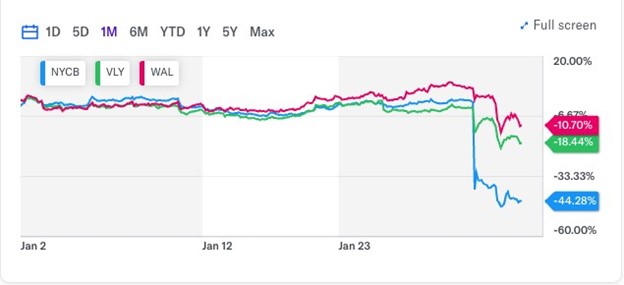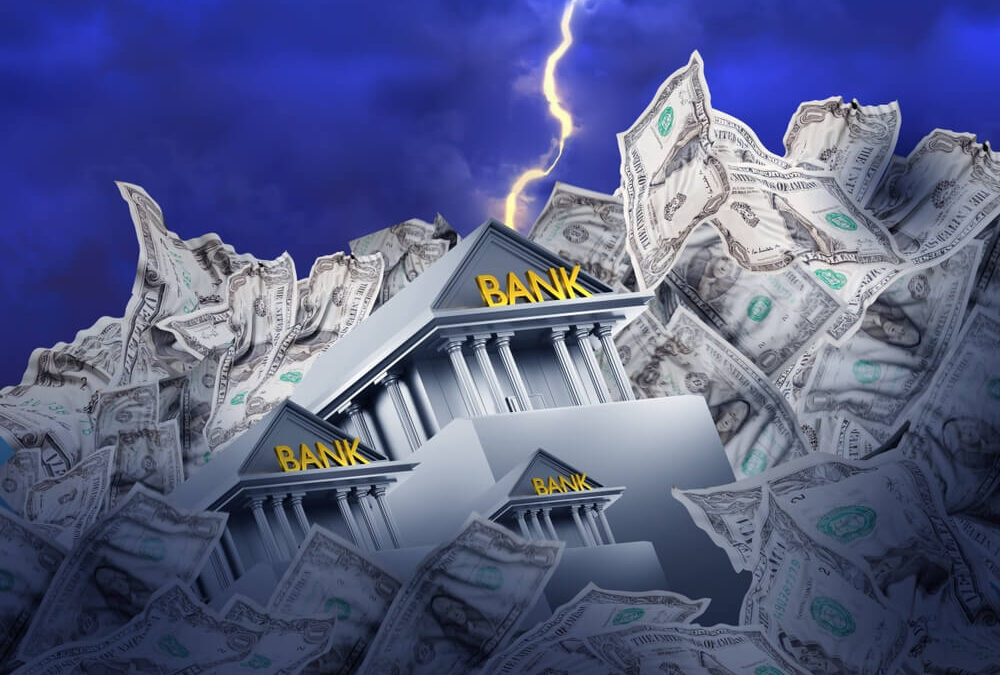“Owning regional banks requires an abnormally high desire for pain.”
That’s what Yang Tang, CEO of fund issuer Arch Indices, said when problems started cropping up for a small bank in New York last week.
Following a surprise 70% dividend cut, regional banking giant New York Community Bank (NYSE: NYCB) shares lost nearly half their value in a single trading session. Other regional bank stocks sank as well, leading to one of the worst days for the sector since last year’s major bank failures:
Is NYCB the Canary in a Coal Mine?

(More on the “why” in just a moment…)
It’s been nearly a year since Silicon Valley Bank, Signature Bank and First Republic Bank failed. The Federal Reserve and the U.S. Treasury took swift action in response to the crisis, assuring depositors and investors that the coast was clear — and the contagion wouldn’t spread.
That rapid response indicated that both the Fed and the Treasury may have learned a few important lessons during the financial meltdown of 2008 to 2009.
The banking business is all about trust and confidence, after all.
And authorities took swift action to preserve that confidence. Even if there was a banking crisis (like the “digital bank run” SVB’s ultra-wealthy clients executed), they wanted everyone to know that they were ready to crank up the printing presses and throw money at the problem until it went away.
The Fed even established an emergency “Bank Term Funding Program” with $25 billion in newly printed cash. They were ready to stop the crisis in its tracks.
However, the situation was still a nightmare for investors.
Long before the bank went bust, SVB stock slumped from heights of $755 per share down to $100 before it was delisted. That’s an 85% loss … and tens of billions in market cap value destroyed … all in a matter of days.
Fast forward, and NYCB emerged as an unlikely hero in the crisis, absorbing massive amounts of Signature Bank’s toxic assets. Now, those same assets are wreaking havoc on NYCB’s portfolio — and NYCB’s investors are paying the price.
So if taxpayers, depositors and investors are losing out during these flash banking crises, who’s really “winning” here?
The traders, that’s who…
2024’s New “Big Short” on Regional Banks
Amid all the chaos of Silicon Valley Bank and Signature Bank failing last year, some smart short sellers saw the risks beforehand … and turned the situation into a windfall profit.
According to financial analytics company Ortex, hedge funds were sitting on unrealized profits of $7.25 billion in March 2023. It was the most profitable month for short sellers since the 2008 financial crisis.
And by the time First Republic ceased operations on May 1, short sellers had pocketed another $1.2 billion.
Even Main Street investors managed to get in on the action, with the chance to pocket multiple gains of up to 108% as regional banking stocks fell.
We did it by buying put options on the S&P Regional Banking ETF (NYSE: KRE).
As I explained to paid-up Max Profit Alert subscribers in one of my short-side recommendations:
If SVB was “unique” and the too-big-to-fail banks can’t collapse … then where’s the bounce in bank stocks’ share prices?
If the damage were truly limited to SVB and Signature Bank, why haven’t KBE and KRE mounted even a short-lived, “dead-cat-bounce” type of rally?
One plausible explanation is that increased scrutiny on regional banks has shifted to another risk: the industry’s exposure to commercial real estate (CRE)…
Sure enough, the market quickly began “pricing in” the rising risk of CRE defaults — sending our puts soaring over the next two months.
But that wasn’t the last opportunity we’ll have to cash in on crashing CRE…
Bank Crisis 2.0: A $1.5 Trillion Tidal Wave of Default
There are currently more than $1.5 trillion in CRE loans set to come due before the end of next year.
You don’t have to be an industry insider to know that CRE hasn’t been doing so well lately. The 2020 lockdowns forced the world into “work from home” mode. And American workers haven’t been rushing back to the office in the years since.
Commercial real estate isn’t anything like residential real estate. Home prices are inherently “sticky” and folks are unlikely to ever walk away from their mortgage (you need a roof over your head, after all).
But the opposite can be true with CRE. Defaulting on a CRE loan can sometimes be a prudent business choice. In other instances, it can be key to keeping a roof over your head. There’s not a lot of incentive to pay for office space no one’s using, especially when times are tough.
The situation is likely worse than you realize, too.
A new report from the National Bureau of Economic Research indicates that nearly half of all banks now risk default and that a 10% default rate would cost commercial banks $80 billion.
And this could all start coming to a head as soon as March 11…
That’s the Fed’s deadline date when its emergency bank funding program will shut down for good.
Without the full backing of Uncle Sam (not to mention unlimited access to his printing presses), regional bank investors could start to lose faith — and another “Phantom Bank Crisis” may make its way into newspaper headlines all over again.
That’s why I’m urging my readers to take immediate action.
I’ve updated my list of 282 Toxic Banking Stocks to Dump Right Away, and created a standalone video update to help you prepare. Take a moment and watch it HERE.
To good profits,

Adam O’Dell
Chief Investment Strategist




